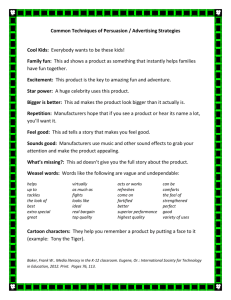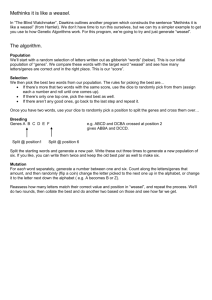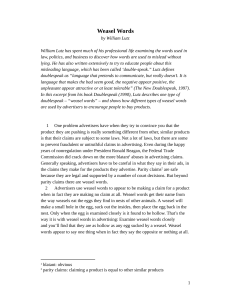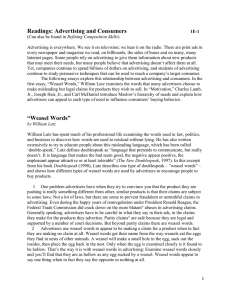Chapter 6 In 2009 the FDA was empowered to regulate Alcohol
advertisement
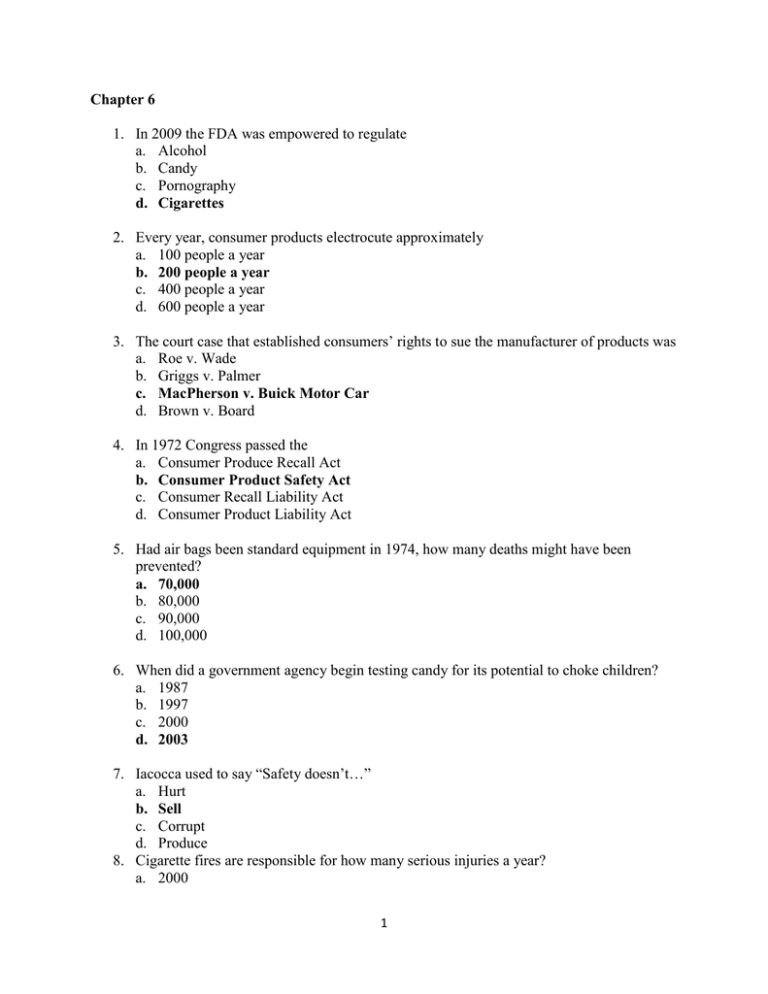
Chapter 6 1. In 2009 the FDA was empowered to regulate a. Alcohol b. Candy c. Pornography d. Cigarettes 2. Every year, consumer products electrocute approximately a. 100 people a year b. 200 people a year c. 400 people a year d. 600 people a year 3. The court case that established consumers’ rights to sue the manufacturer of products was a. Roe v. Wade b. Griggs v. Palmer c. MacPherson v. Buick Motor Car d. Brown v. Board 4. In 1972 Congress passed the a. Consumer Produce Recall Act b. Consumer Product Safety Act c. Consumer Recall Liability Act d. Consumer Product Liability Act 5. Had air bags been standard equipment in 1974, how many deaths might have been prevented? a. 70,000 b. 80,000 c. 90,000 d. 100,000 6. When did a government agency begin testing candy for its potential to choke children? a. 1987 b. 1997 c. 2000 d. 2003 7. Iacocca used to say “Safety doesn’t…” a. Hurt b. Sell c. Corrupt d. Produce 8. Cigarette fires are responsible for how many serious injuries a year? a. 2000 1 b. 4000 c. 6000 d. 7000 9. The claim that a product is fit for its ordinary use is a. An implied warranty b. An explicit warranty c. A condition of sale d. A consumer risk 10. When manufacturers and retailers agree to set prices, this is a. Horizontal price fixing b. Vertical price fixing c. Backwards price fixing d. Lowered price fixing 11. Until was it illegal for a manufacturer and a retailer to fix prices? a. 1876 b. 1965 c. 1987 d. 2007 12. A seller’s exploitation of a short-term situation in which buyers have few purchase options for a much-needed product is called a. Price gouging b. Racketeering c. Prix fixe d. Worker exploitation 13. The question of what a fair price is a. Is easy to answer b. Probably lacks a precise answer c. Is a confused question d. Best left to economists 14. When a “economy size” product is sold at a higher price than their smaller counterparts they are being subject to a. Extra taxes b. A quantity surcharge c. Fraud d. Limited cost savings 15. L’Occitane labels its products in a. Sign language b. Braille c. French 2 d. English 16. Ads that can be understood in two or more ways are a. Ambiguous b. Illegal c. Immoral d. Concealing 17. Words used to evade direct statements are a. Ferret words b. Hedgehog words c. Weasel words d. Mandrake words 18. In advertising, a claim that is unsupported by evidence is a. An opinion b. An exaggeration c. A false promise d. A weasel claim 19. A persuasive effort aimed primarily at emotion is a a. Weasel appeal b. Psychological appeal c. Exaggerated appeal d. Puffed-up appeal 20. Advertising that communicates at a level beneath conscious awareness is a. Deceptive b. Weasel worded c. Illegal d. Subliminal 21. The Federal Trade Commission was created in a. 1876 b. 1890 c. 1914 d. 1954 22. The Federal Trade Commission was created as a. An antitrust weapon b. An investment watchdog c. A consumer advice bureau d. A body for overseeing interstate commerce 23. The decision in FTC v. Standard Education led the FTC to apply which standard liberally? 3 a. b. c. d. The ignorant person standard The informed consumer standard The reasonable person standard The ignorant retailer standard 24. Every year children under twelve spend a. $20 billion b. $40 billion c. $60 billion d. $80 billion T 1. Every year teenagers spend $172 billion. T 2. Exposure to television ads is associated with childhood obesity. F 3. Food companies spend $16 billion a year marketing to children. T 4. Kenneth Galbraith rejected the economists’ faith in consumer sovereignty. F 5. Kenneth Arrow invented the dependence effect. T 6. Advertising subsidizes the media. F 7. Consumers cannot sue manufacturers of defective products. T 8. Every year lawn mowers send 78,000 consumers to emergency rooms. T 9. The doctrine of strict product liability holds that the manufacturer of a product must compensate its users for injuries suffered because of its defective condition. F 10. Manufacturers can defend against charges of strict product liability by showing that they were not negligent in the manufacturing process. T 11. The number of automobile recalls per year has doubled since 1993. T 12. In 2008 California effectively outlawed retail sales of raw milk. 1. Do you believe that manufacturers should be responsible for injuries suffered by consumers as a result of defective products, or not? If so, what do you think is the strongest argument against your position, and how do you respond to it? If not, why not? 4 2. Should we allow consumers to make decisions for themselves concerning how much safety they are willing to sacrifice for cheaper products, or not? Justify your answer. If you think we should, what legislative steps should we take to achieve this? If you think not, how protected should consumers be? 3. How effective do you think regulation currently is? Would leaving the market to its own devices be more, or less, effective? Argue for your view. 4. Do you think that an attempt to maximize products at the expense of consumer safety is immoral? Do you think that it would be immoral if this was generally recognized as a business practice? 5. Do you agree with Galbraith’s analysis of the dependence effect? Why, or why not? 6. Do you think that there should be any restrictions on advertising? If yes, what should they be? If no, why not? 5
